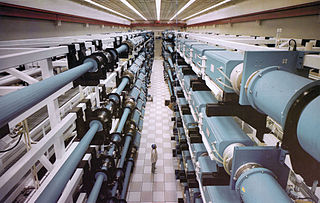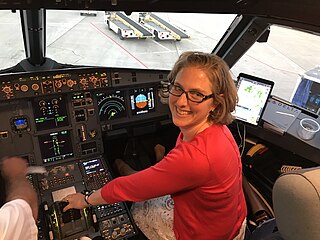Related Research Articles

Inertial confinement fusion (ICF) is a fusion energy process that initiates nuclear fusion reactions by compressing and heating targets filled with fuel. The targets are small pellets, typically containing deuterium (2H) and tritium (3H).
This timeline of nuclear fusion is an incomplete chronological summary of significant events in the study and use of nuclear fusion.

The National Ignition Facility (NIF) is a laser-based inertial confinement fusion (ICF) research device, located at Lawrence Livermore National Laboratory in Livermore, California, United States. NIF's mission is to achieve fusion ignition with high energy gain. It achieved the first instance of scientific breakeven controlled fusion in an experiment on December 5, 2022, with an energy gain factor of 1.5. It supports nuclear weapon maintenance and design by studying the behavior of matter under the conditions found within nuclear explosions.
The Laboratory for Laser Energetics (LLE) is a scientific research facility which is part of the University of Rochester's south campus, located in Brighton, New York. The lab was established in 1970 with operations jointly funded by the United States Department of Energy, the University of Rochester and the New York State government. The Laser Lab was commissioned to investigate high-energy physics involving the interaction of extremely intense laser radiation with matter. Scientific experiments at the facility emphasize inertial confinement, direct drive, laser-induced fusion, fundamental plasma physics and astrophysics using the OMEGA Laser Facility. In June 1995, OMEGA became the world's highest-energy ultraviolet laser. The lab shares its building with the Center for Optoelectronics and Imaging and the Center for Optics Manufacturing. The Robert L. Sproull Center for Ultra High Intensity Laser Research was opened in 2005 and houses the OMEGA EP laser, which was completed in May 2008.

Inertial Fusion Energy is a proposed approach to building a nuclear fusion power plant based on performing inertial confinement fusion at industrial scale. This approach to fusion power is still in a research phase. ICF first developed shortly after the development of the laser in 1960, but was a classified US research program during its earliest years. In 1972, John Nuckolls wrote a paper predicting that compressing a target could create conditions where fusion reactions are chained together, a process known as fusion ignition or a burning plasma. On August 8, 2021, the NIF at Livermore National Laboratory became the first ICF facility in the world to demonstrate this. This breakthrough drove the US Department of Energy to create an Inertial Fusion Energy program in 2022 with a budget of 3 million dollars in its first year.
Fusion ignition is the point at which a nuclear fusion reaction becomes self-sustaining. This occurs when the energy being given off by the reaction heats the fuel mass more rapidly than it cools. In other words, fusion ignition is the point at which the increasing self-heating of the nuclear fusion removes the need for external heating. This is quantified by the Lawson criterion. Ignition can also be defined by the fusion energy gain factor.

Magnetized liner inertial fusion (MagLIF) is an ongoing fusion power experiment being carried out on the Z Pulsed Power Facility at Sandia National Laboratories in the US. It is one example of the broader magneto-inertial fusion approach, which attempts to compress a pre-heated plasma. The goal is to produce fusion conditions without the level of compression needed in the inertial confinement fusion (ICF) approach, where the required densities reach about 100 times that of lead.
LASNEX is a computer program that simulates the interactions between x-rays and a plasma, along with many effects associated with these interactions. The program is used to predict the performance of inertial confinement fusion (ICF) devices such as the Nova laser or proposed particle beam "drivers". Versions of LASNEX have been used since the late 1960s or early 1970s, and the program has been constantly updated. LASNEX's existence was mentioned in John Nuckolls' seminal paper in Nature in 1972 that first widely introduced the ICF concept, saying it was "...like breaking an enemy code. It tells you how many divisions to bring to bear on a problem."

Omar Hurricane is a physicist at Lawrence Livermore National Laboratory, in the thermonuclear and inertial confinement fusion design division. Hurricane completed his Ph.D. at the University of California, Los Angeles (UCLA) under the supervision of Professor René Pellat in 1994. He remained at UCLA as a postdoc under adviser Steven Cowley, studying the kink and nonlinear ballooning mode instability in high-beta plasmas until joining LLNL in 1998 as a designer in A-Division.
John Hopkin Nuckolls is an American physicist who worked his entire career at the Lawrence Livermore National Laboratory. He is best known for the development of inertial confinement fusion, which is a major branch of fusion power research to this day. He was also the lab's director from 1988 until 1994, when he resigned to become an associate director at large. He was awarded the Ernest Orlando Lawrence Award in 1969, the James Clerk Maxwell Prize for Plasma Physics in 1981, the Edward Teller Award in 1991, the Department of Energy Distinguished Associate Award in 1995, the Lifetime Achievement Award in 1996 by Fusion Power Associates, the Secretary of Defense Medal for Outstanding Public Service in 1996, and the Enrico Fermi Presidential Award in 2024.
The Edward Teller Award is an award presented every two years by the American Nuclear Society for "pioneering research and leadership in the use of laser and ion-particle beams to produce unique high-temperature and high-density matter for scientific research and for controlled thermonuclear fusion". It was established in 1999 and is named after Edward Teller. The award carries a $2000 cash prize and an engraved silver medal.
John D. Lindl is an American physicist who specializes in inertial confinement fusion (ICF). He is currently the chief scientist of the National Ignition Facility at the Lawrence Livermore National Laboratory.
Jürgen Meyer-ter-Vehn is a German theoretical physicist who specializes in laser-plasma interactions at the Max Planck Institute for Quantum Optics. He published under the name Meyer until 1973.
The history of nuclear fusion began early in the 20th century as an inquiry into how stars powered themselves and expanded to incorporate a broad inquiry into the nature of matter and energy, as potential applications expanded to include warfare, energy production and rocket propulsion.
Christine Garban-Labaune is a French plasma physicist known for her research in inertial confinement fusion.

Tammy Ma is an American plasma physicist who works on inertial confinement fusion at the Lawrence Livermore National Laboratory.
Denise Hinkel is a plasma physicist at Lawrence Livermore National Laboratory.

Carolyn C. Kuranz is an American plasma physicist whose research involves the use of high-powered lasers at the National Ignition Facility both to help develop inertial confinement fusion and to study how matter behaves in conditions similar to those in shock waves in astrophysics. She is an associate professor at the University of Michigan, in the Department of Nuclear Engineering and Radiological Sciences.

Andrea Lynn "Annie" Kritcher is an American nuclear engineer and physicist who works at the Lawrence Livermore National Laboratory. She was responsible for the development of Hybrid-E, a capsule that enables inertial confinement fusion. She was elected Fellow of the American Physical Society in 2022.

Maria Gatu Johnson is a Swedish-American plasma physicist whose research involves the use of neutron spectrometry to study inertial confinement fusion and stellar nucleosynthesis. She works at the Massachusetts Institute of Technology as a principal research scientist in the MIT Plasma Science and Fusion Center.
References
- ↑ "Betti, Riccardo | Department of Physics and Astronomy". www.pas.rochester.edu. Archived from the original on 2008-02-08.
- ↑ "Riccardo Betti - Laboratory for Laser Energetics". www.lle.rochester.edu. Archived from the original on 2010-09-18.
- ↑ "Home - Unit - DPP".
- ↑ "Dawson Award".
- ↑ "Pascal Medal".
- ↑ "Prize Recipient".
- ↑ "Office of Science".
- ↑ "FPA Awards".
- ↑ "American Nuclear Society -- ANS".
- ↑ "bpa_membership". sites.nationalacademies.org. Archived from the original on 2009-08-28.
- ↑ "Office of Science" (PDF).